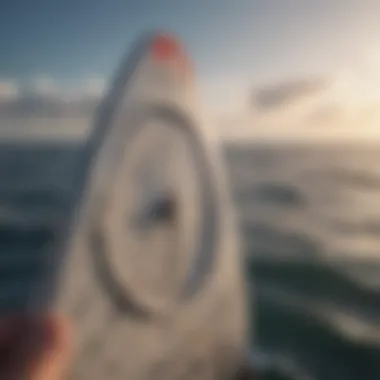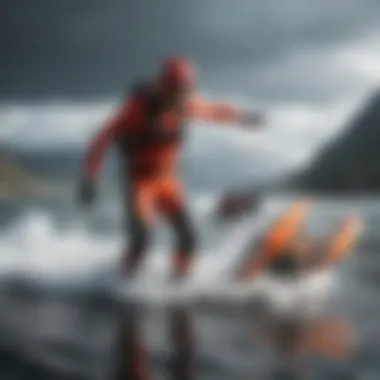Understanding Weather Maps for Watersports Safety


Intro
Understanding weather maps and wind direction is vital for anyone engaged in watersports. These elements dictate not only safety but also the potential for enjoyment while participating in activities like sailing, surfing, and paddleboarding. A thorough comprehension of these concepts allows enthusiasts to make informed decisions about when and where to engage in their water activities.
Water Activity Overview
Watersports encompass a wide range of activities, each with unique factors influenced by weather and wind. Here, we will explore a few popular watersport activities.
Surfing
Surfing is heavily reliant on wind and wave conditions. Wind direction can swell or flatten waves. Onshore winds can create choppy surf conditions, while offshore winds often result in cleaner waves. Practicing surf forecasting by analyzing weather maps can be immensely beneficial.
Sailing
Sailing requires a good understanding of wind patterns. Sailors must know how to read winds to harness their power effectively. A favorable wind direction means better speed and maneuverability. Understanding weather maps helps sailors pinpoint optimal conditions for their outings.
Snorkeling
Snorkeling is less affected by wind compared to surfing or sailing but still requires attention to tidal changes. Weather maps can help snorkelers anticipate changes in currents and visibility, improving the overall experience.
Paddleboarding
Paddleboarding is sensitive to both wind and water conditions. Enthusiasts should pay attention to weather forecasts, as strong winds can create rough conditions. Reading wind patterns can prevent accidents and enhance enjoyment on the water.
Tips and Techniques
Tips for beginners
- Start by understanding basic weather terms.
- Check local weather forecasts before going out.
- Use simple weather maps for quick references.
Diagnosing wind direction is crucial for all beginners. Even minor changes in wind can influence performance.
Advanced techniques for experienced enthusiasts
- Study seasonal wind patterns to predict conditions.
- Use advanced apps and tools that provide real-time information.
- Understand how to adapt to changing conditions swiftly.
Safety guidelines
- Always monitor weather updates before entering the water.
- Keep communication devices handy in case of emergencies.
- Know how to respond to sudden weather changes.
Gear Reviews
Choosing the right gear can drastically affect your performance and enjoyment. Here are some key items tailored for each watersport.
Surfboards
Selecting the right surfboard depends on your experience and the type of waves. Consider brands like Channel Islands which offer a range for all levels.
Sailboats
For sailing, options like Hobie Cat have proven reliable among enthusiasts for their durability and performance.
Snorkeling equipment
Quality gear from Cressi can enhance your underwater experience, ensuring comfort and efficiency.
Paddleboards
For paddleboarding, look into Red Paddle Co which specializes in inflatable paddleboards, great for storage and transport.
Wetsuits


A well-fitted wetsuit from O'Neill is essential for chilly waters, providing warmth as well as buoyancy.
Destination Guides
Finding the right location can enhance your watersport activities significantly. Here are some key insights.
Popular water sports locations
Some popular spots include:
- Cape Town, South Africa for surfing.
- The Whitsundays, Australia for sailing.
- The Great Barrier Reef for snorkeling.
Hidden gems for water enthusiasts
Places like El Nido in the Philippines offer stunning secluded spots for snorkeling and paddleboarding, away from crowds.
Travel tips for water sports trips
- Research local regulations regarding watersports.
- Always check the weather forecast before traveling.
- Explore local forums on Reddit to get firsthand insights from other enthusiasts.
"Understanding the conditions before you hit the water can make all the difference between a great day and one that’s cut short."
Preface to Weather Maps
Weather maps serve a vital role in providing essential information for watersports enthusiasts. Understanding weather maps is crucial for those who partake in activities such as sailing, surfing, kayaking, and paddleboarding. These maps visually represent atmospheric conditions that can directly impact the safety and enjoyment of water activities.
By learning to interpret weather maps, enthusiasts can make informed decisions about when and where to engage in their preferred sports. Comprehending elements such as temperature, precipitation, pressure systems, and wind directions can greatly enhance performance and safety.
Definition of Weather Maps
Weather maps offer a graphical representation of meteorological data over a specific area. They illustrate various atmospheric variables at a given time, allowing users to visualize and understand complex weather conditions. These maps are indispensable tools for predicting short-term weather changes and for planning outdoor activities.
Components of Weather Maps
- Temperature scales: Temperature scales on weather maps indicate atmospheric warmth or chill. They help watersports enthusiasts assess conditions that could affect their performance. The most common scales used are Celsius and Fahrenheit. Knowing the temperature is crucial in determining how comfortable or even safe it may be to participate in particular sports. A significant aspect of temperature scales is their ability to show gradients, which can indicate approaching weather systems.
- Precipitation indicators: Precipitation indicators are symbols used on weather maps to show expected rainfall or snowfall. These indicators are crucial for planning watersports since rain can influence water levels and conditions. Understanding the precipitation can help in making decisions, such as whether to proceed with a sailing trip or avoid it entirely due to impending storms. The unique feature of these indicators is their ability to convey amounts and intensity, giving clarity to potential disruptions.
- Pressure systems: Pressure systems, marked as high or low on weather maps, significantly influence wind patterns and storm formation. High-pressure systems typically indicate fair weather, while low-pressure systems can lead to turbulent conditions. For watersports enthusiasts, recognizing these patterns is essential. They help predict the likelihood of storms or calm periods, impacting safety and enjoyment. One unique feature of pressure systems is their ability to affect local weather patterns, which can be crucial when planning activities.
- Wind vectors: Wind vectors represent wind direction and speed on weather maps. They are depicted using arrows that show the flow of air. For watersports enthusiasts, understanding wind vectors can make or break a day on the water. The direction of the wind can determine the suitability of conditions for activities such as sailing or windsurfing. A strong understanding of wind dynamics is crucial for predicting how the wind will impact water surfaces and performance.
Understanding Wind Direction
Wind direction plays a crucial role in various aspects of watersports. Knowledge of how wind is measured and interpreted helps enthusiasts make better decisions related to their activities. Understanding wind direction is not just about knowing which way the wind blows; it affects water conditions, safety, and overall enjoyment of watersports. Factors such as sailing, surfing, and paddleboarding are significantly influenced by wind patterns. Watersports enthusiasts can use this knowledge to plan effective outings, manage risks, and enhance performance.
What is Wind Direction?
Wind direction indicates the origin point of the wind. It is typically expressed as a compass direction, representing where the wind comes from. For example, a wind direction stated as "north" means the wind is coming from the north towards the south. Understanding the wind's source helps watersports enthusiasts to predict the conditions they may encounter. This knowledge is particularly important when considering safety and success in any water activity.
Units of Measurement
Degrees and cardinal points
Wind direction is commonly measured using degrees on a 360-degree compass. In this system, north is 0 degrees, east is 90 degrees, south is 180 degrees, and west is 270 degrees. This method provides a clear and precise means to identify wind origin.
The use of cardinal points like north, east, south, and west simplifies communication about wind direction. It offers a universal language for enthusiasts and allows for quick understanding. The degree system is beneficial, especially when determining specific angles, which can influence the performance of sailing boats or the dynamics of wave riding in surfing.
However, using degrees may become complicated for those unfamiliar with coordinate systems. A straightforward understanding of cardinal points may be more accessible for beginners.
Beaufort scale
The Beaufort scale is a system for estimating wind speed by observing its effects on people, water, and the environment. It ranges from 0 (calm) to 12 (hurricane) and categorizes wind intensity. Each level describes specific wind conditions and offers a descriptive term, such as "light breeze" or "gale."
The Beaufort scale is advantageous for watersports enthusiasts, as it translates wind speed into practical insights regarding conditions on the water. For instance, understanding that a force 4 (moderate breeze) could make sailing exciting yet manageable is helpful in planning.
However, the scale's subjective nature can be a disadvantage, as individuals may adjust their observations based on personal experiences. Also, it does not provide specific measurements, potentially leading to confusion among less experienced users.


Interpreting Weather Maps
Interpreting weather maps is essential for watersports enthusiasts because it provides critical insights into the weather conditions affecting various water activities. An accurate reading of weather maps can inform individuals about potential risks and optimal conditions. Understanding these maps helps in planning outings, ensuring safety, and enhancing the overall experience on the water.
Reading Temperature Gradients
Temperature gradients on weather maps indicate areas of differential heating in the atmosphere. This is important because changes in temperature influence wind patterns, which directly affect watersports. A steep temperature gradient often suggests strong winds. Enthusiasts need to pay attention to these gradients as they can forecast rapid changes in weather conditions. For example, in coastal areas, a line of demarcation between warm and cool air can create turbulent waters, influencing sailing and surfing.
- Visual Indicators: Isotherms are lines connecting points of equal temperature on a map. Understanding their orientation and spacing helps forecast wind strength and direction.
- Practical Insight: Monitor these gradients regularly before heading to the water, as they can signal approaching storms or stable weather.
Assessing Precipitation Projections
Precipitation projections on weather maps serve as a guide for watersport planning. Areas shaded in blue or green typically indicate expected rainfall. Familiarity with these projections helps enthusiasts prepare adequately for wet conditions which can drastically alter water activities.
- Recognizing Symbols: Different symbols represent various types of precipitation. Understanding these symbols lays the groundwork for making informed decisions.
- Strategic Planning: Knowing when and where precipitation is likely helps in scheduling activities. Avoiding periods of heavy rain can lead to more enjoyable experiences on the water.
Identifying High and Low Pressure Areas
High and low pressure areas are fundamental components of weather maps. High pressure generally indicates fair weather, while low pressure is associated with unsettled conditions.
- Impact on Winds: Winds flow from high to low pressure, creating different wind patterns that are crucial for watersports like sailing and paddleboarding. Understanding these areas allows individuals to predict wind strength and direction, which are vital for navigation and safety.
- Key Considerations: Watersport enthusiasts should observe moving low pressure systems. Such systems can lead to sudden weather changes, making them a significant factor in planning outings.
"Understanding the dynamics of pressure systems can save you from dangerous conditions on the water. Always check pressure maps before heading out."
The Role of Wind in Watersports
Wind plays a crucial role in shaping the experience of various watersports. For sailing, surfing, paddleboarding, and kayaking, understanding how wind interacts with water is essential for both performance and safety. Familiarity with wind patterns allows enthusiasts to make informed decisions. This knowledge can enhance enjoyment while minimizing risks associated with sudden weather changes.
Impact on Sailing
Sailing relies heavily on wind direction and velocity. Sailboats operate by harnessing wind energy through their sails. Optimal wind conditions propel a sailboat smoothly, ensuring an efficient journey. Different points of sail affect a sailor's strategy. For instance, when sailing upwind, a sailor must navigate at an angle, capturing the wind effectively while minimizing drag. Conversely, sailing downwind opens opportunities for speed, using the wind to its full advantage.
However, unpredictable winds can create challenges. Gusts and shifts in wind direction may disrupt a planned course, leading to difficult maneuvers. This unpredictability necessitates attentiveness to weather maps and forecasts.
Influence on Surf Conditions
For surfers, wind is a double-edged sword. On one hand, it can create excellent wave conditions. Offshore winds tend to flatten the surface waves, making them cleaner and more rideable. On the other hand, onshore winds may lead to choppy water and less favorable surfing conditions.
Experienced surfers track local wind patterns closely to identify the best times and places to surf. Understanding the relationship between wind and swell is vital. Techniques such as observing wind direction and its impact on wave formation can help surfers choose favorable conditions.
Significance for Paddleboarding and Kayaking
Paddleboarding and kayaking also depend on wind awareness. For paddleboarders, wind can make paddling more challenging, especially during crossing situations. Headwinds create resistance, while tailwinds can help increase speed. Understanding when to paddle against the wind or take advantage of tailwinds can be the difference between an enjoyable outing and a strenuous struggle.
Kayakers must also consider wind conditions, particularly in open water. Strong winds can lead to dangerous waves and currents, posing risks during navigation. Having skills to counteract wind influence is important for safety and performance. When planning a kayaking trip, enthusiasts should check wind forecasts to choose routes that minimize exposure to hazardous conditions.
"Understanding wind conditions is key to maximizing the safety and enjoyment of any watersport."
Practical Wind Directions for Watersports
Understanding practical wind directions is vital for watersports enthusiasts. Whether you are sailing, surfing, or paddling, the wind significantly shapes your experience on water. Knowing the optimal direction of the wind can enhance performance and safety, allowing for a more enjoyable outing.
Optimal Wind Conditions
Wind direction plays a crucial role in determining the conditions of various watersport activities.
- Sailing: The ideal wind direction for sailing typically ranges between 10 to 20 knots from the broadside of the boat. This allows for effective tacking and sailing performance.
- Surfing: For surfers, an offshore wind, which flows from the land towards the sea, is often preferred. This type of wind helps in creating clean and well-formed waves.
- Paddleboarding: For paddleboarding, cross-shore winds are favorable as they assist in the stabilization of the board, making for a more controlled paddling experience.
Understanding these specific wind needs can greatly enhance your watersport activities, making each session on the water more fulfilling.
Avoiding Hazardous Winds


It is important to recognize that not all wind conditions are favorable. Certain wind patterns can pose significant risks:
- Strong Onshore Winds: These winds, blowing from the sea to the land, can create challenging conditions for activities like surfing and paddleboarding. They can create dangerous waves and make it hard to return to shore.
- Gusty Winds: Unpredictable gusts can be problematic for sailing, as they can lead to loss of control. It’s essential to stay vigilant to changes in wind strength and direction.
- Crosswinds: For sailing, a strong crosswind can complicate maneuvering, making it difficult to maintain a straight course or tack effectively.
Technological Tools for Weather Forecasting
In the realm of watersports, understanding the weather is crucial for safety and optimal performance. Technological tools for weather forecasting have emerged as valuable resources for enthusiasts. These tools provide timely information about wind patterns, precipitation, and other climatic factors. Having access to accurate weather data can make a significant difference between a pleasant outing and a hazardous experience on the water. The integration of technology allows sports enthusiasts to plan their activities with greater foresight and confidence.
Weather Apps and Websites
Using weather apps and reliable websites is an essential part of staying informed. Many applications and sites specialize in marine weather information, offering functionality that caters specifically to watersports enthusiasts. Some notable apps include Windy, AccuWeather, and Weather Underground. These platforms provide real-time updates on wind speed and direction, temperature changes, and upcoming storm alerts.
Benefits of using these tools include:
- Timeliness: Instant notifications on changing weather conditions help users make informed decisions quickly.
- Customization: Many apps allow users to set specific parameters for their activities, such as preferred wind speeds.
- Mapping Features: Visual representations of local weather patterns can help predict how conditions will evolve.
When choosing a weather app or website, consider factors such as user interface, accuracy of reports, and specific features relevant to watersports. A well-chosen tool can greatly enhance your experience.
Use of Wind Forecasting Models
Wind forecasting models are advanced tools that simulate and predict wind behavior based on various atmospheric conditions. They play a fundamental role in understanding how wind patterns will develop over time. Systems like the Global Forecast System (GFS) and the European Centre for Medium-Range Weather Forecasts (ECMWF) use complex algorithms to analyze data collected from weather stations around the world.
Key advantages of utilizing these models include:
- Precision: High-resolution models can provide specific wind direction and speed forecasts for your exact location.
- Long-Term Planning: These models can help users plan trips days in advance, adjusting for potential weather changes.
- Understanding Trends: Regular use of forecasting models can aid in recognizing trends in local weather, influencing the best times for various watersports.
By integrating wind forecasting models into your planning routine, you can enhance both safety and enjoyment in your watersport activities.
Safety Considerations for Watersports
Participating in watersports provides thrilling experiences, but it also carries risks. Understanding safety considerations is crucial for ensuring that these activities are enjoyable and secure. This section elaborates on the significance of safety measures tailored for enthusiasts of various water activities. Prior knowledge can lead to better decision-making, minimizing dangers and maximizing fun.
Understanding Weather Alerts
Weather alerts serve as crucial notifications for watersport participants. Understanding these warnings is vital. Alerts indicate various conditions, such as severe storms, high winds, or any weather phenomena that could lead to hazardous situations on the water.
For example, a small craft advisory may caution against strong winds, advising paddlers and sailors to remain onshore. Similarly, a tornado or severe thunderstorm warning could affect safety, requiring immediate action. It's essential to stay updated with local weather forecasts and have a plan if conditions become unfavorable. Using reliable apps and news resources can keep enthusiasts informed.
Here are some components to consider when monitoring weather alerts:
- Local News Stations: Tune into broadcasts for updates.
- Mobile Alerts: Enable notifications from apps designed for weather forecasting.
- Radio: Continuous updates from NOAA Weather Radio can be life-saving.
By recognizing the importance of these alerts, participants can react swiftly, ensuring their safety and that of others.
Preparation and Gear Management
Effective preparation is another linchpin of safety in watersports. Having the right gear and being knowledgeable about its use can drastically improve safety measures.
Before heading out, participants must assess their equipment. Paddlers should ensure their kayaks have proper buoyancy aids; surfers must check their boards for integrity. Moreover, wearing life jackets at all times during activities is not just advisable, it is often required.
Consider these key preparation steps:
- Inspect your Equipment: Regular checks can spot wear and tear, ensuring each piece is functional.
- Know Your Limits: Understand your abilities in relation to the conditions. Wind and waves can quickly turn a pleasant outing into a challenge.
- Plan Ahead: Establish a timeline and inform a trusted person about your water outing. This will allow for timely checks if you do not return as expected.
Culmination
Conclusively, understanding weather maps and wind direction is pivotal for watersports enthusiasts. These elements directly influence the enjoyment and safety of various water activities. Grasping the intricacies of weather maps allows athletes and adventurers to anticipate changing conditions, which can significantly affect performance and, at times, safety.
Summary of Key Points
- Weather Maps: Provides visual representations of meteorological data, including temperature, precipitation, and pressure systems.
- Wind Direction: Knowing how to interpret wind patterns helps in making informed decisions while engaging in watersports.
- Practical Application: Understanding the data helps enthusiasts to choose the right conditions for sailing, surfing, and kayaking, enhancing their experience and safety.
- Technological Tools: Various apps and websites assist in real-time monitoring of weather changes, contributing further to better planning and preparedness.
Moving Towards Greater Awareness
Improving awareness about weather conditions is not merely academic. It leads to better planning and increased safety in watersports. Watersports enthusiasts must educate themselves about how to read and interpret weather maps, thereby reducing risks. Regularly checking forecasts through reliable sources like weather apps can be a crucial habit. This proactive mindset empowers enthusiasts to make the most of their ventures, ensuring that every experience is both enjoyable and secure.
"Knowledge is power. For those who seek enjoyment in watersports, understanding the weather is not an option; it is a necessity."















